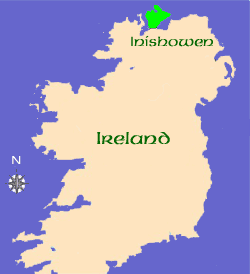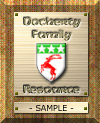The Docherty
Family and its name hold a rich tradition in the history of Ireland.
Nearly 1,000 years before the birth of Christ, the Celts battled
their way across what is now Europe. Comprised of multiple divisions,
the westernmost group of these nomadic warriors were called the Gaels.
When they arrived at what became their final destination...an island
well protected by rugged cliffs...they named it "Eire" ...Ireland.
Over
time, the country's political and social fabric was dictated by its
many family clans, each under its own chief. The clans held
tribal territories that eventually consolidated into four large
geographic kingdoms: Ulster, Munster, Leinster and Connacht. The
northernmost point in Ireland -- in Ulster -- is a peninsula named
Inishowen.
The peninsula was named
after a son of Niall of the Nine Hostages who was the High King
of Ireland between 346 and 406 A.D. One of
Niall's hostages was a boy named Patrick in 403 A.D. That boy would
later become St. Patrick. The family O'Dochartaigh is descended
from Niall's son, Conall Gulban. It was after Conall that Tyr Conaill
(now County Donegal) was named. Our family got its name from Dochartach,
son and heir of Maongal, the grandson of Fianan, Lord of Inishowen.
He was the 12th in lineal descent from Conall Gulban.
Through
the years, Tyr Conaill became the site for many fierce battles
including the McLaughlin's vs. the O'Neill's. After the
defeat of the McLaughlin's, in about 1208, the O'Dochartaigh clan
held undisputed power over the Inishowen peninsula. The area covered
more than 300,000 lush acres and many castles, the ruins of which
are still visible today.
In the historic rebellion of
1608, Cahir O'Dogherty aided by the Clann McDevitt captured the
fort at Culmore, burned the city of
Derry and killed the English Governor, Sir George Paulet. The English
responded quickly and Cahir was slain at Doon Rock, Kilmacrenan,
attempting to maintain the clan's territory. He was decapitated
and his head was displayed on a pole outside Dublin Castle. Cahir
thus became the last of the Gaelic Irish chiefs, and his sword
is now housed at The Tower Museum in Derry City.
Thanks to Brian Baker
for some of the background information. |
|
 |
 |
 |
 |
 |
 |
 |
 |
 |
 |
Do
you have a site that's either dedicated to the Docherty Family
or provides a valuable resource for our extended clan?
If the
answer is yes, you may be eligible to display the Docherty
Family Resource plaque on your site! After you send us an email
with your site's URL, we'll personalize your plaque for your
site. |
 |
|
|
|
|
|
|
|
|

